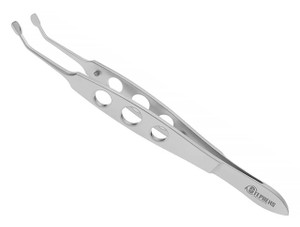The Role of Meibomian Forceps in the Management of Meibomian Gland Dysfunction
Meibomian Forceps are a specialized ophthalmic Instrument used by ophthalmologists and optometrists to treat meibomian gland dysfunction (MGD), a condition that affects the meibomian glands, which produce the oil layer of the tear film. Meibomian gland dysfunction can cause dry eyes, redness, and discomfort, and is a common condition that affects many people.
In this blog post, we will discuss what Meibomian Forceps are, how they work, and their benefits in treating MGD.
What are Meibomian Forceps?
Meibomian Forceps are specialized instruments used to perform meibomian gland expression, a procedure used to treat MGD. Meibomian gland expression involves applying pressure to the meibomian glands to clear blockages and release the oils that they produce.
Meibomian Forceps are made of high-quality stainless steel, which is durable and easy to clean. They come in different sizes and designs, including straight and curved tips, to suit the needs of different patients and practitioners.
How do Meibomian Forceps work?
Meibomian Forceps work by applying gentle pressure to the meibomian glands, which helps to clear any blockages and release the oils that they produce. The procedure involves inserting the forceps into the eyelids and gently squeezing them to express the meibomian glands.
Meibomian Forceps are designed to be comfortable for both the patient and the practitioner during the procedure. The curved or angled tip can make it easier to access certain areas of the eyelid, while the straight tip may be more suitable for smaller glands.
What are the benefits of Meibomian Forceps?
Meibomian Forceps offer several benefits in the treatment of meibomian gland dysfunction:
- Improved meibomian gland function: Meibomian Forceps help to clear blockages in the meibomian glands, which can improve the quality and quantity of the oils they produce.
- Reduction in MGD symptoms: By improving meibomian gland function, Meibomian Forceps can alleviate symptoms associated with MGD, such as dry eyes, redness, and discomfort.
- Increased tear film stability and quality: The oils produced by the meibomian glands are an essential component of the tear film, which helps to lubricate and protect the eyes. By improving meibomian gland function, Meibomian Forceps can increase tear film stability and quality.
- Enhanced patient comfort during the procedure: Meibomian Forceps are designed to be comfortable for both the patient and the practitioner during the procedure, which can help to minimize discomfort and improve patient satisfaction.
- Cost-effective and easy-to-use tool for practitioners: Meibomian Forceps are a cost-effective and easy-to-use tool for practitioners, which can help to improve the efficiency and effectiveness of meibomian gland expression procedures.
Conclusion
Meibomian Forceps are an essential tool for ophthalmologists and optometrists who treat patients with meibomian gland dysfunction. By improving meibomian gland function, Meibomian Forceps can alleviate symptoms associated with MGD and improve the quality of life for those affected by this condition.
If you are experiencing symptoms of dry eyes or other discomfort related to meibomian gland dysfunction, talk to your ophthalmologist or optometrist about whether meibomian gland expression or other treatments may be appropriate for you. Meibomian Forceps can be a useful tool in the treatment of MGD, and can help to improve the quality of life for those affected by this condition.
Some sources you might find helpful include the American Academy of Ophthalmology (https://www.aao.org/) and the National Institutes of Health (https://www.nih.gov/).
Blog Post Sponsored By AccuSpire.Com



 Apr 12th 2023
Apr 12th 2023